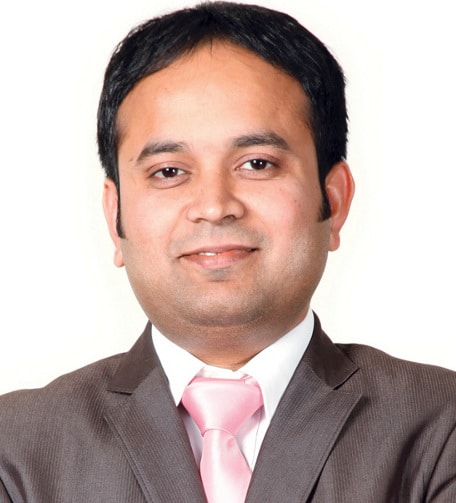
ESDS, one of the worlds leading data centre services and cloud solutions providers, has a US patent for its method of resource allotment and requirements. In other words, this is a patent for auto scalability. Piyush Somani, founder, MD and CEO of ESDS Software Solutions Pvt Ltd, talks about his company and the benefits of having a patent with the Open Source For You team.
Q How would you describe ESDS as a company?
A. ESDS is a leading managed cloud and data centre service provider in India with subsidiaries in the US and UK. It has been in business for more than a decade and has assisted thousands of organisations in transforming their presence online. ESDS takes pride in hosting more than two million websites and supporting a customer base of over 35,000 from every country connected to the Internet. The business of a significant number of these corporate entities is dependent on their Internet presence. ESDS has an Uptime Institute certified Tier 3 DC at Mumbai and a Tier 3 DC at Nashik, along with multiple leased facilities in the US, UK and other cities across India. The companys people believe in innovation, combined with great customer service.
Q How have you differentiated yourselves from players like Rackspace, or other Indian players?
A. Data centre players in India fall under different categories. There are standalone data centre players that provide only co-location services, which means that they sell power, cooling and space only. Then there are data centres owned by the telecom players that are leveraging the advantage of bandwidth connectivity (so the DC business naturally complements what they do), and then there are managed service providers. By and large, ESDS falls into the third category of data centres in India providing managed services.
The differentiation that ESDS provides is the expertise in offering customised solutions as against standard product offerings. ESDS believes in innovation and has its own R&D team that is CMMI 3 certified. The team has developed quite a few great data centre related products that are used by major enterprises in India today. Our biggest differentiator is a unique auto-scaling cloud solution called eNlight, which is combined with pay-per-consume billing. eNlight has a patent from the USPTO (United States Patent and Trademark Office) for auto scaling of resources in real-time. Compared to Rackspace, we offer vertical real-time scaling and a pay-per-consume billing mode, which are clear differentiators. Our eNlight 360 provides users the power to manage various diverse hypervisors from a single control panel.
Q Does ESDS provide anything like a platform-as-a-service or are you at the purely data centre level?
A. Currently, we are a big time IaaS provider while we do provide certain software on the SaaS model. We have recently launched an e-commerce platform that we provide as a service but, going forward, we will be focusing on providing various types of PaaS.
Q ESDS has a US patent for the methods it uses for resource allotment and requirements or, in other words, for auto scalability. Can you tell us more about what this is all about?
A. A virtual machine (VM) is a typical instance of IaaS, which consists of the CPU, RAM, the network, the disk and operating system with optional preinstalled applications. The patent is for the method and system for detecting, in real-time, the resource requirements of a system in a virtual environment and automatically scaling resource parameters according to these requirements. The virtual machine controller constantly measures resource utilisation in the servers and virtual machines associated with it. If a resource requirement is detected with any virtual machine, the automatic resource scaling system detects the type of resource to be scaled, and scales the selected resource. Further, the resource may be scaled up or scaled down, based on the requirements. The scaled resource could be the CPU, RAM, disk or any such resource. This system helps to save space and power without compromising security, performance and accessibility.
Q How does having such a patent impact the growth of a business?
A. The patented technology does help as a key enabler for an organisations growth. We are accustomed to always following the big brothers in technology, but when you have a patent from the United States for a unique product, it helps local enterprises to develop faith in products that are made in India. It also becomes a clear differentiator regarding an organisations strength in technology as compared to other providers, and it shows our commitment to innovate unique solutions to help businesses, which in turn helps in the nations growth.
Q Where is your main data centre located?
A. Our Uptime Institute certified Tier 3 data centre is located at Mahape in Navi Mumbai and our head office, along with our Tier 3 data centre, is situated in the heart of Nashik.
Q What would you say is the key factor driving this group?
A. A passion for continuous innovation and the trust of each single employee in our vision of creating lifetime customer relationships (by providing cloud enabled solutions and managed data centre services) are the two key factors driving the group.
Q Then the challenge is more about proving to be a better option as compared to the competitors, rather than having to sell the concept?
A. We do not believe in or focus on proving ourselves as a better option. We believe in continuous innovation rather than competing. Competition is about getting better, centered across something similar, while our goal is to give the world niche, cost-effective technology solutions. We come up with solutions that fill the gap, and serve to eliminate the pain areas of our technology, thereby eliminating the need to sell any concept that might or might not take off.
Q And how much is the business and revenue from international clients?
A. Revenue from Indian clients has crossed US$ 6 million, while revenue from our international clients is more than US$ 12 million.
Q Has the recent rule from the government of India to have more data centres located within India, particularly those related to the government, benefited you in any way?
A. Currently, the government is working on empanelling Indian data centres for government institutions to host their applications and data. Once this is done, government organisations and PSUs would no longer be required to host their data at the state data centres, and this will definitely benefit private data centre players.
Q Would it be correct to assume that most of the customers are going to be high-end premium customers rather than small players?
A. We have a mix of hosting customers. The business of the majority of our international customers is high-volume with the per-customer revenue generation being low, whereas in India, we are seeing mostly high-end premium customers getting on board and opting for our services.
Q Has any startup grown with you?
A. Yes, there are many startups that are hosted with us and some of them have grown 20 times in the last three years. Due to our terms of non-disclosure, I would be unable to identify them publicly.
Q Do you have any special programmes for startups?
A. Our unique and innovative pay-per-consume billing model itself is a special offering for startups. While cloud providers bill the customers for the allocation, eNlight cloud bills the customers for actual usage of resources. This is something similar to the electricity billing model that we are accustomed to at our homes. We have also assisted startups to have compute as a utility on a prepaid billing model such as mobile SIM cards. This billing model helps the clients save more than 30 per cent compared to the pay-per-use model.
Q There is a lot of talk about the IoT. What is your personal take on this? Do you see a huge amount of business coming to cloud companies also because of IoT?
A. The IoT is the future and it is not very far away. We will see another data explosion from the point we are at today. Every instrument comes with multiple sensors attached to it today, be it a small watch, a pen or a mobile all the way up to aircrafts and rockets. Companies are coming up with digital products, but where is all this data going to get stored? These companies are not coming up with their own data centres. With the world moving towards a machines controlling machines era, the business of the cloud is going to grow multifold in the next three to five years and IoT is going to be a clear driver for this. IoT feeds into another revenue stream that goes by the name of Big Data analytics. Finally, the data has to be transformed into information that is meaningful and can be used.
Q What does open source mean to ESDS?
A. ESDS is a strong believer in open source technologies. We believe that, very soon, proprietary systems will be a thing from the past and those who do not embrace open systems will follow suit. Our products are completely built on open source platforms. We also have a very unique way of demonstrating a cross-platform concept, under which customers can do a PoC (proof of concept) of their proprietary systems on open platforms in our data centre.
Q Where do you see revenue coming from — customers seeking an open source stack or those with a preference for the proprietary stack.
A. We are seeing organisations taking the initiative of moving to the open source stack, and the numbers are increasing each day. Customers are embracing open source technologies for non-critical loads for sure, while trying out PoC for their critical systems. Currently, the revenue would be around 50-50 but, going forward, the trend is definitely skewing towards open source stacks.
Q You have mentioned that you are seeing growth coming from the telecom sector, existing customers shifting to the cloud and from e-commerce. As I understand, these are the top three sources. Will this trend to continue or do you see any new sectors emerging?
A. Telecom players are always the trend setters in this industry. Fortunately, e-commerce companies were mostly startups, so they could directly move to the cloud, while the existing customers who have invested heavily in their infrastructure are already starting to move their workloads to the cloud, as their infrastructure is approaching the end of its life. Everyone is moving from the capex to the opex model, and many organisations have already realised the pain of having an in-house data centre. With the Digital India initiative, the government will contribute to the business at large, and with our vertical auto scaling technology, industries in oil and gas, or aviation, or those that use legacy systems, will be able to take advantage of the cloud, thereby contributing to growth.
Q So what is the biggest challenge for your business?
A. The biggest challenge in the data centre industry is the huge capital required to build and maintain the data centre. The investments needed to boost this industry in India are still not happening at the rate they should be. There is also the challenge of skilled manpower, since it is a different kind of industry with varied technology and the skills needed are not readily available in abundance. Besides, the cost of power and bandwidth is still very high compared to developed nations, thereby increasing the operating expenses.
Q. Lastly, what are the top three or five technology trends that you would want a typical CIO or CTO to keep in mind when it comes to the cloud, or even migrating to it?
A. The hybrid cloud, the Internet of Things, Dockers and more initiatives around Devops, interoperability and security should be what CIOs or CTOs keep their eyes on.











































































